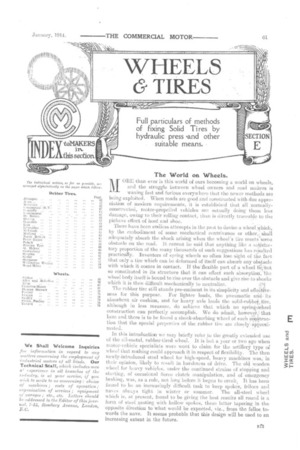WHEELS • & TIRES
Page 63

If you've noticed an error in this article please click here to report it so we can fix it.
Full particulars of methods of fixing Solid Ti res by hydraulic press .and other suitable means.
The World on Wheels.
A, / ORE than ever is this world oi ours becoming a world on wheels, 1 I and the struggle between wheel owners and road makers is waxing fast and furious everywhere that the newer methods are being exploited. When roads are good and constructed with due appreciation of modern requirements, it is established that all normallyconstructed, motor-propelled vehicles are actually doing them less damage., owing to their rolling contact, than is directly traceable to the .. • pickaxe effect of hoof and shoe. . . • .. There have been endless attempts in the past to devise a wheel which, by the embodiment of sonic mechanical contrivance or other„ ,shall adequiately absorb the shock arising when the wheel's tire meets Some obstacle on the road.. it cannot be said that anything like a sai,isfaetory proportion of the many thousands of such suggestions has resulted practically. inventors of spring wheels so often lose sight of the.fact that only a tire which can be deformed of itself can absorb any obstacle with which it comes in contact. If the-flexible part of a wheel 4,1not so constituted in its structure that it can effect such absorption, the wheel body itself is bound to rise over the obstacle and give rise to shocks which it is then difficult mechanically to neutralize. ,J2.,.. The rubber tire still stands pre-eminent in its simplicity and effective ness for this purpose. For 'lighter loads, the pneumatic and.-:•:its absorbent air cushion, and for heavy axle loads the solid-rubb4tire, although in less measure, do 'achieve that which no spring heel construction can perfectly accomplish. We do admit, howeverthat hero and there is to be found a shock-absorbing wheel of such e4kruction that the special properties of the rubber tire are elosely:!apiprosimated.
in this introductice we may briefly referzto the greatly extended use of the ail-metal, rubber-tired wheel.. It is but a year or two ago when motor-vehicle specialists were wont to claim for the artillery type of wheel that nothing could approach it in respect of flexibility. The then newly-introduced steel wheel for high-speed, heavy machines was, in their opinion, likely to result in harshness of drive. The old wooden . wheel for heavy vehicles, under the continued strains of stoPping and storting; of occasional fierce dutch manipulation, and of emergency braking, was, as a rule., not long before it began to creak.. It has been found to be an increasingly difficult task to keep spokes, felloes awl naves always tight in winter or summer. The all-steel wheel which is, at present, found to be giving the best results all round is a form of steel .,casting with hollow spokes, these latter tapering in the opposite direction to. 'what would be expected, viz., from the .felloe.towards the nave. It seems probable that this design will be used to an increasing extent in the future.






















































































